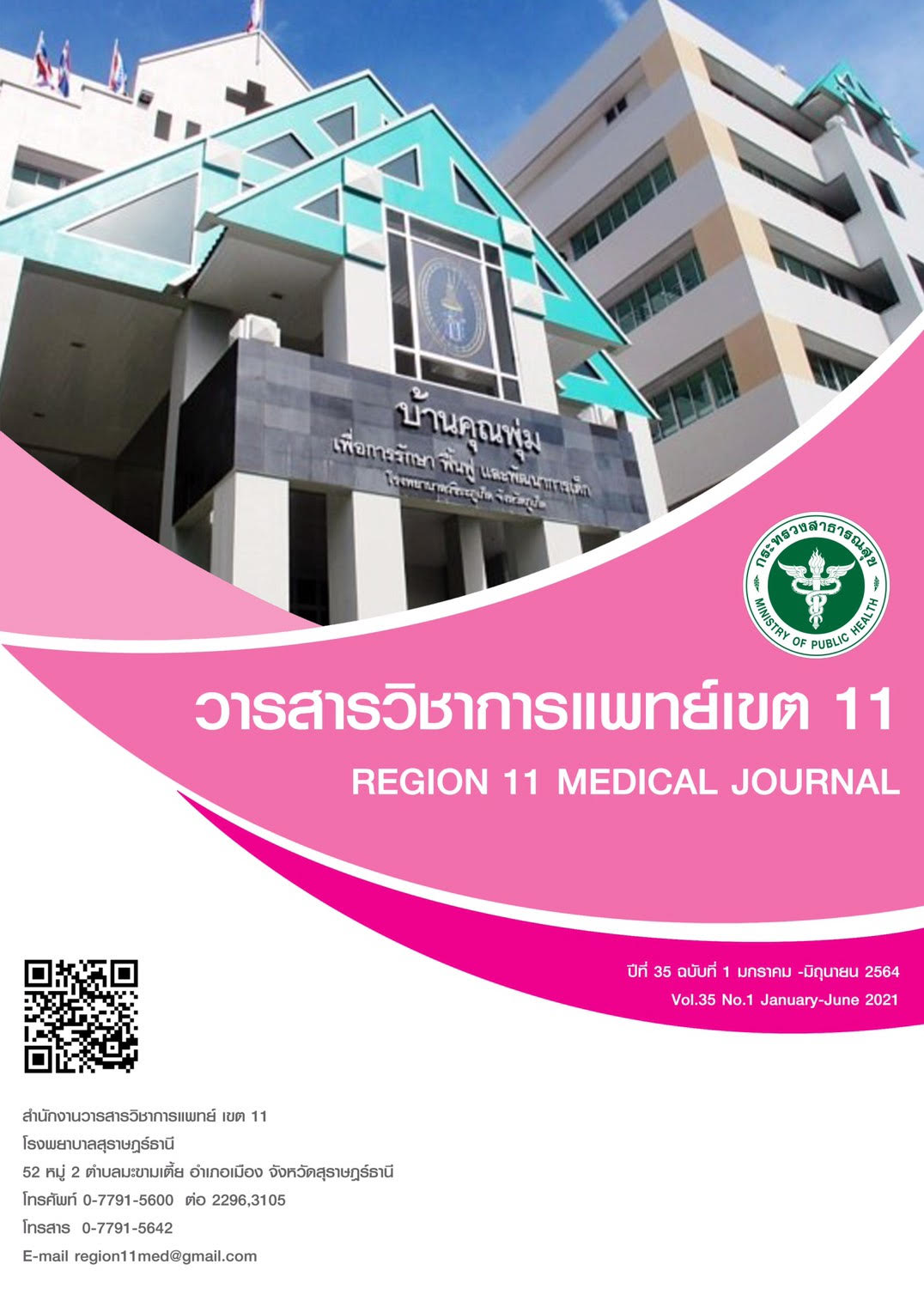Factors Influencing Mortality in Road Traffic Accident Patients go to Neurosurgery at Krabi Hospital
Keywords:
neurosurgery, intra-operative blood loss, traumatic brain injury, road traffic accidentAbstract
Background: Road traffic accident mortality is still challenging problem in Thailand. Most of deaths result from traumatic brain injury.
Objective: This study aims to identify factors influencing mortality in road traffic accident patients go to neurosurgery at Krabi hospital.
Methods: The study is quantitative retrospective study that collected data during 1 January to 31 December 2018.
Results: The results of study found that 44 patients, male to female ratio was 2.38:1, had mortality rate 27.27%. Most of deaths were male (75%), young age (0-20 year) 33.3%, no underlying disease (91.7%) and had additional injuries (50%). Most of them were diagnosed acute subdural hematoma (66%), craniectomy was done (83.3%) and had intra-operative blood loss over 750 ml (75%) resulting in average pre to post-operative hematocrit was decreased from 39.3% to 28.9% respectively. Logistic regression analysis shown that blood loss over 750 ml is statistically significant factor that influencing mortality by adjusted OR 22.7 (95%CI=3.64-141.69, p=0.001).
Conclusion: We conclude that peri-operative blood loss over 750 ml influence mortality in road traffic accident patients go to neurosurgery. This data reinforce the need for continuous monitoring and improving treatment of blood loss in brain injured patients during post-crash period.
References
World Health Organization. Global status report on road safety 2018 [Internet]. 2018 [cited 2020 April 29]. Available from: http://www.who.int/violence_injury_prevention/road_safety_status/2018/en/.
สำนักงานนโยบายและแผนการขนส่งและจราจร กระทรวงคมนาคม. รายงานการวิเคราะห์สถานการณ์อุบัติเหตุทางถนนของกระทรวงคมนาคม พ.ศ. 2561 [อินเทอร์เน็ต]. 2562 (เข้าถึงเมื่อ 29 เม.ย. 2563). เข้าถึงได้จาก: http://www.otp.go.th/uploads/tiny_uploads/PDF/2562-09/25620916Accident%20report2561%20_OTP.pdf.
สำนักงานหลักประกันสุขภาพแห่งชาติ. ข้อมูลการบาดเจ็บจากอุบัติเหตุการขนส่งทางบกที่รับไว้รักษาในโรงพยาบาลของระบบหลักประกันสุขภาพแห่งชาติระหว่างปี 2558-2561 [อินเทอร์เน็ต]. 2562 (เข้าถึงเมื่อ 29 เม.ย.2563). เข้าถึงได้จาก: https://www.nhso.go.th/frontend/NewsInformationDetail.aspx?newsid=MjYyNQ==.
Dewan MC, Rattani A, Gupta S, Baticulon RE, Hung Y-C, Punchak M, et al. Estimating the global incidence of traumatic brain injury. Journal of neurosurgery. 2018;130(4):1080-97.
สมประสงค์ ทองมีสี. Thailand’s inhospital trauma statistics [อินเทอร์เน็ต]. 2561 (เข้าถึงเมื่อ 29 เม.ย. 2563). เข้าถึงได้จาก: http://www.rajavithi.go.th/rj/5thTE/wp-content/uploads/sites/25/2018/07/1.Trauma-statistics_นพ.สมประสงค์-ทองมีสี-โรงพยาบาลชลบุรี.pdf.
วิภูรัฐ ปุสสนาคะวาทิน. ปัจจัยที่มีผลต่อการรักษาผู้ป่วยบาดเจ็บที่สมองอย่างรุนแรงในโรงพยาบาลกระบี่. วารสารวิชาการสาธารณสุข. 2558;24:329-36.
สุจินต์ รุจิเมธาภาส. ปัจจัยที่มีผลต่อผลลัพธ์การผ่าตัดในผู้ป่วยบาดเจ็บสมองจากอุบัติเหตุ. วารสารสมาคมเวชศาสตร์ป้องกันแห่งประเทศไทย. 2558;5:207-13.
วิสิทธิ์ เสถียรวันทนีย์. อัตราตายของผู้บาดเจ็บที่ศีรษะที่รักษาในหน่วยศัลยกรรมประสาท โรงพยาบาลพุทธชินราช พิษณุโลก ปี 2548-2550. พุทธชินราชเวชสาร. 2551;25:83-9.
Ryan CG, Thompson RE, Temkin NR, Crane PK, Ellenbogen RG, Elmore JG. Acute traumatic subdural hematoma: current mortality and functional outcomes in adult patients at a Level I trauma center. The journal of trauma and acute care surgery. 2012;73(5):1348.
Røe C, Skandsen T, Anke A, Ader T, Vik A, Lund SB, et al. Severe traumatic brain injury in Norway: impact of age on outcome. Journal of rehabilitation medicine. 2013;45(8):734-40.
Alagoz F, Yildirim AE, Sahinoglu M, Korkmaz M, Secer M, Celik H, et al. Traumatic acute subdural hematomas: analysis of outcomes and predictive factors at a single center. Turk Neurosurg. 2017;27(2):187-91.
ฉัตรชัย สีสรรพ์. ปัจจัยที่มีผลต่อผลลัพธ์ของการผ่าตัดผู้ป่วยบาดเจ็บสมองจากอุบัติเหตุในโรงพยาบาลกระบี่. วารสารวิชาการแพทย์เขต 11. 2559;30(2):37-45.
Manley G, Knudson MM, Morabito D, Damron S, Erickson V, Pitts L. Hypotension, hypoxia, and head injury: frequency, duration, and consequences. Archives of Surgery. 2001;136(10):1118-23.
Chi JH, Knudson MM, Vassar MJ, McCarthy MC, Shapiro MB, Mallet S, et al. Prehospital hypoxia affects outcome in patients with traumatic brain injury: a prospective multicenter study. Journal of Trauma and Acute Care Surgery. 2006;61(5):1134-41.
World Health Organization. Save LIVES: a road safety technical package [Internet]. Geneva: World Health Organization; 2017 [cited 2020 April 29]. Available from: https://www.who.int/publications/i/item/save-lives-a-road-safety-technical-package.
Yattoo G, Tabish S, Afzal WM, Kirmani A. Factors influencing outcome of head injury patients at a tertiary care teaching hospital in India. International journal of health sciences. 2009;3(1):59.
Gruenbaum SE, Ruskin KJ. Red blood cell transfusion in neurosurgical patients. Current opinion in anaesthesiology. 2014;27(5):470.
Bagwe S, Chung LK, Lagman C, Voth BL, Barnette NE, Elhajjmoussa L, et al. Blood transfusion indications in neurosurgical patients: a systematic review. Clinical neurology and neurosurgery. 2017;155:83-9.
East JM, Viau-Lapointe J, McCredie VA. Transfusion practices in traumatic brain injury. Current opinion in anaesthesiology. 2018;31(2):219.
Boutin A, Moore L, Lauzier F, Chassé M, English S, Zarychanski R, et al. Transfusion of red blood cells in patients with traumatic brain injuries admitted to Canadian trauma health centres: a multicentre cohort study. BMJ open. 2017;7(3).
Downloads
Published
How to Cite
Issue
Section
License
Copyright (c) 2021 Region11Medical Journal

This work is licensed under a Creative Commons Attribution-NonCommercial-NoDerivatives 4.0 International License.






